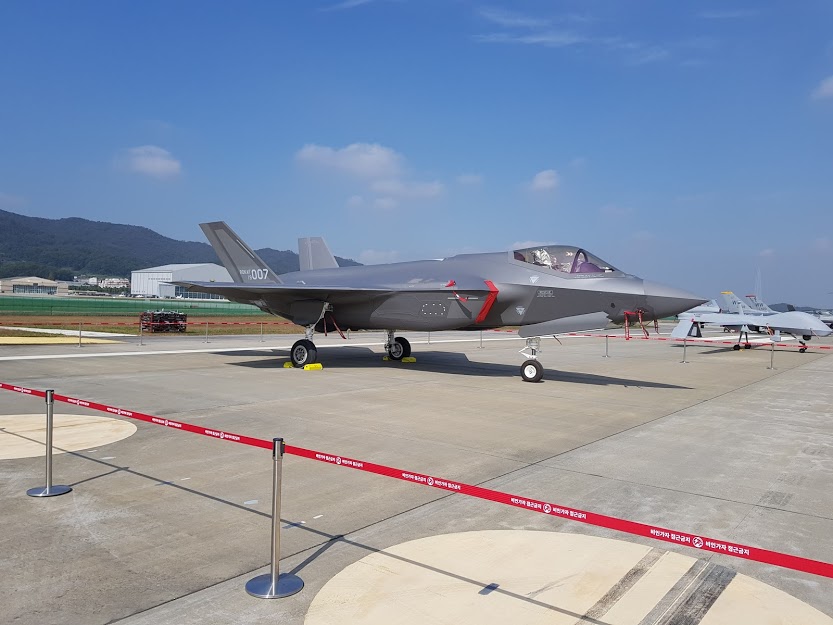Lockheed Martin has defended both the stealth coatings of the F-35A and its efforts to boost the supply of spare parts, as it eyes the conclusion of three fighter campaigns in 2020 and lower operating costs.
While 2019 has been a relatively trouble-free year in the programme’s long history, reports have emerged regarding concerns about the durability of its low-observable coatings at high speeds, as well as continued issues with spare parts availability.
Speaking at the Seoul International Aerospace & Defence Exhibition (ADEX) in October, Steve Sheehy, F-35 director sustainment strategies and campaigns, acknowledged that there was an issue that required the replacement of rain erosion tape on the fighter’s leading edges, but that the coating itself is “rock solid”.

A Republic of Korea Air Force F-35A at ADEX show
Greg Waldron
“It’s a generational jump from previous stealth aircraft,” he says.
Lockheed’s F-35 factory in Fort Worth, Texas, has a doormat made from the jet’s low-observable skin. “Every year they pick it up and check it, and it still holds that LO quality,” Sheehy says.
Steve Over, director international business, adds: “It’s seen tens and tens of thousands of steps. People jump on it, stomp on it... it’s just one thing we use to prove the durability of the coating system.”
More importantly, they contend, the coating is easily applied in the field and requires no environmental control facility as with previous versions of stealth aircraft. Lockheed says the interval between maintenance events for the F-35’s low-observable coating is now 19h – better than the targeted 9h.
On the issue of spares, which has proven a challenge as F-35 numbers have grown, Sheehy says that standard practice formerly involved issuing contracts for individual jets before contracts for spare parts.
“[This meant] spares are constantly chasing the aircraft, driving a problem with supply. We’ve fixed that, putting over $2 billion of our own money to fund all these spare parts. So, in 2020 when an aircraft arrives, the spares will already be in place. That will fix that problem. The spares will be populated for those airframes.”
Over adds that 2021 will be an important year for the F-35, with competitions in Canada, Finland and Switzerland likely to be decided. There are also considerable longer-term opportunities.
“There are a lot of potential markets,” says Over. “We’re in conversations with countries in Europe who are thinking about recapitalising old fleets. None of them have matured to the point that [countries such as] Finland, Switzerland and Canada have, but there is definitely a market well into 2030 and beyond for nations recapitalising fourth-generation fleets.”
Meanwhile, Over notes that the F-35 programme continues to see falling airframe costs, as discussions continue on low-rate initial production blocks 12, 13 and 14, covering a combined 478 of the stealth aircraft.
“We have not finalised the exact dollar amount for each of the airplanes in [production lots] 12, 13 and 14, but we and the US government have agreed that [the cost of a] Lot 13 airplane will start with a seven, and lot 14 will be even cheaper. We continue down the price curve, and we haven’t reached bottom yet. We'll be below $80 million for an F-35A in Lot 13.”













































